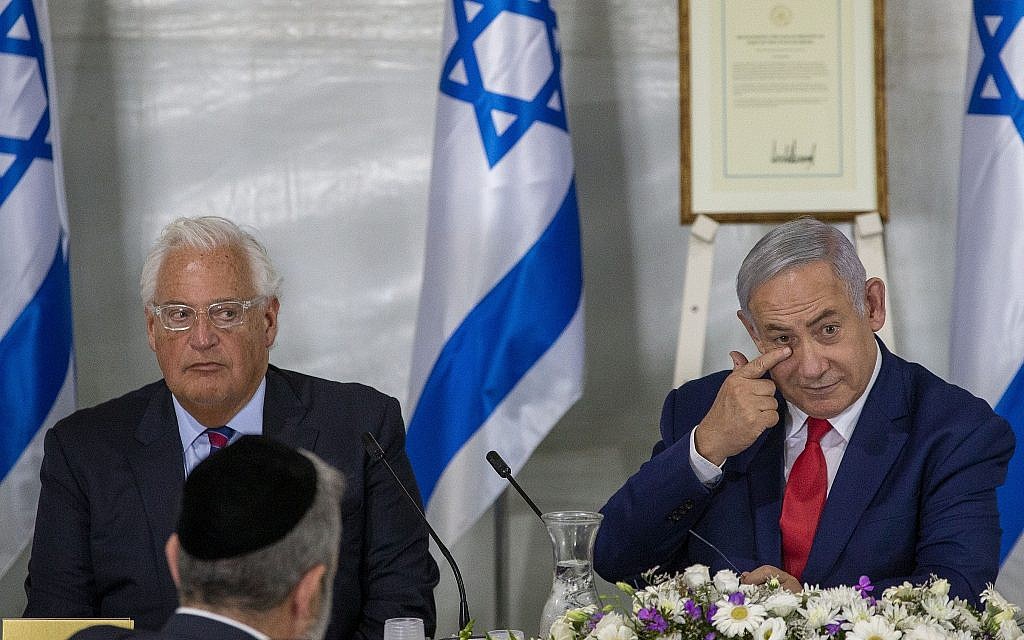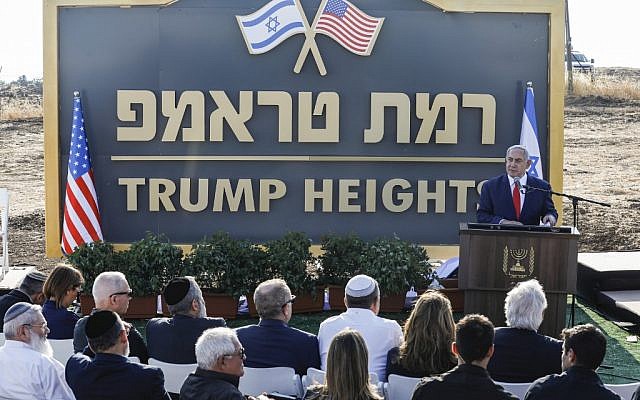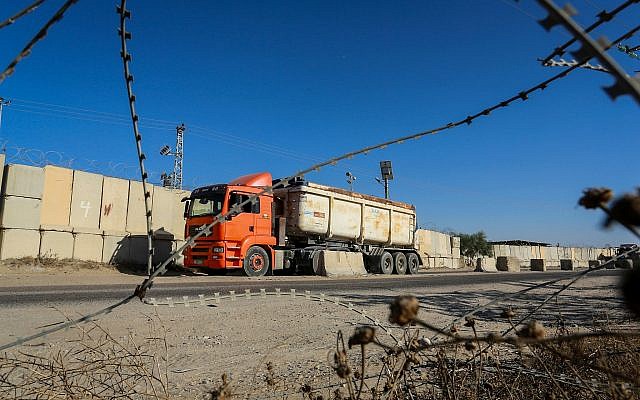 White House economic peace plan may be tough to sell Netanyahu
White House economic peace plan may be tough to sell Netanyahu
RON KAMPEAS
Document outlining Peace to Prosperity scheme includes measures that would require security compromises, likely putting the prime minister and others on the right in a bind
 Israeli Prime Minister Benjamin Netanyahu convenes his Cabinet with United States Ambassador to Israel David Friedman to inaugurate a new settlement named after President Donald Trump in a gesture of appreciation for the U.S. leader’s recognition of Israeli sovereignty over the Golan Heights, Sunday, June 16, 2019. (AP/Ariel Schalit)
Israeli Prime Minister Benjamin Netanyahu convenes his Cabinet with United States Ambassador to Israel David Friedman to inaugurate a new settlement named after President Donald Trump in a gesture of appreciation for the U.S. leader’s recognition of Israeli sovereignty over the Golan Heights, Sunday, June 16, 2019. (AP/Ariel Schalit)
WASHINGTON (JTA) — Days ahead of a workshop where Jared Kushner will seek tens of billions of dollars for his Middle East peace plan, the White House unveiled an outline of its economic portion, including proposals, like a Gaza-West Bank link, that are sure to rattle Israel’s government.
The “Peace to Prosperity” plan authored by a team led by Kushner, President Donald Trump’s son-in-law, was posted on the White House website on Saturday. It does not outline the political portion, which the plan architects say will come in November, after Israel’s September elections.
The economic plan’s 40 pages enthusiastically endorse expressions of Palestinian identity, from Palestinian desserts to universities, and hint at political outcomes that could upset Israeli Prime Minister Benjamin Netanyahu’s plans to forge a coalition with parties to the right of his Likud Party. Not mentioned, however, is Palestinian statehood.
In addition to the Gaza-West Bank link, which would inevitably cross Israeli territory, there are proposals to register Palestinian ownership of land and to allow Palestinian farmers greater access to water and arable land.
These outcomes would put Netanyahu in a tough squeeze: He has been unremitting in his embrace of Trump, who has recognized Jerusalem as Israel’s capital, recognized Israeli sovereignty over the Golan Heights, pulled out of an Iran nuclear deal Netanyahu loathes, defunded the Palestinians and effectively campaigned for Netanyahu in April’s election.
 Prime Minister Benjamin Netanyahu gives a speech before the newly-unveiled sign for the new settlement of “Ramat Trump”, or “Trump Heights” in English, named after the incumbent US President during an official ceremony in the Golan Heights on June 16, 2019. (Jalaa MAREY / AFP)
Prime Minister Benjamin Netanyahu gives a speech before the newly-unveiled sign for the new settlement of “Ramat Trump”, or “Trump Heights” in English, named after the incumbent US President during an official ceremony in the Golan Heights on June 16, 2019. (Jalaa MAREY / AFP)
Kushner’s plan envisions $50 billion, to be disbursed on building infrastructure and capacity in the West Bank and the Gaza Strip, as well as to promote trade and tourism partnerships with Egypt Jordan, and Lebanon, with portions of the funding to go to these countries.
Neither the 40-page plan nor the accompanying 96-age breakdown of how the money will be spent, mention statehood. Kushner has said he doesn’t find the term useful, and David Friedman, the US ambassador to Israel, has said that the political portion of the plan will relinquish to Israel security control of the West Bank, suggesting that full Palestinian sovereignty was not on the table. Netanyahu has retreated from favoring a two-state outcome and has said he plans on extending Israeli sovereignty to Jewish settlements in the West Bank.
The Palestinian Authority, which is boycotting the workshop next week in Bahrain, has rejected the plan unseen in part because it seems clear it will stop short of statehood and of a Palestinian claim to a portion of Jerusalem. The plan and its annex, which breaks down in detail where funds should go, do not mention Jerusalem at all.
 Palestinian protesters burn an American flag during a protest at the Gaza Strip’s border with Israel, Friday, April 6, 2018. (AP Photo/ Khalil Hamra)
Palestinian protesters burn an American flag during a protest at the Gaza Strip’s border with Israel, Friday, April 6, 2018. (AP Photo/ Khalil Hamra)
“A B C economics is that no monetary value can predicate or substitute economic sovereignty which is the first requirement for prosperity,” Husam Zomlot, the Palestine Liberation Organization envoy to Washington until he was expelled last year by the Trump administration to punish the Palestinians for their boycott of peace talks, said on Twitter.
Kushner in an interview with Reuters, which reported the plan before it was posted, said its publication could bring around skeptics.
“I find that in the real world, the way you solve problems is by really going into the details, putting forward proposals, agreeing, disagreeing on certain things — that’s very healthy, that’s how you resolve a conflict,” he said. “Remember, nobody agrees up until right before they do so. It’s not unexpected for people to posture and to criticize things but what we’re hoping to do is create a framework where we can change the discussion and get people to look at these problems differently and more granularly and hopefully in a way that can lead to some breakthroughs.”
Elements of the plan portend security compromises Netanyahu might be loath to make. Chief among these is a $5 billion transportation project that would link the Gaza Strip and the West Bank.
 Palestinian trucks seen at the Kerem Shalom crossing, the main passage point for goods entering Gaza from Israel, July 9, 2018 (Abed Rahim Khatib/Flash90)
Palestinian trucks seen at the Kerem Shalom crossing, the main passage point for goods entering Gaza from Israel, July 9, 2018 (Abed Rahim Khatib/Flash90)
read more: White House economic…to sell Netanyahu
